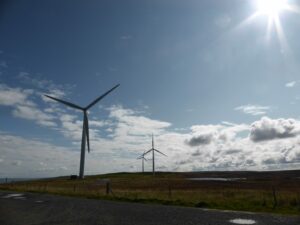
An ongoing research project reminds us of the ways in which archaeology encompasses even the most recent and widest uses of material culture. Orkney Energy Landscapes is a collaborative project between The Archaeology Institute, UHI, here in Orkney, and the University of St Andrews. It has been designed to look at the way our need for energy has helped to shape the landscape through the millennia. From peat cuttings to wind and marine turbines, the machinery created to service our energy requirements is visible within any local environment, and Orkney has a particularly rich record that extends from the earliest times to the present day.
It is an exciting project.
The need for energy has always been a part of human life and it has left a footprint on the landscape. In Orkney for many millennia it was integral to the local culture of self-sufficiency, satisfied by peat-cutting, the collection of driftwood, and other small-scale sources of power. In recent decades, though Orkney is now well-connected into mainstream electricity, oil and other grids, local developments have once again seen some exciting responses to fulfilling that need into the future. As the parameters of energy production have changed, so we have come to an increasing realisation that traditional energy sources based on fossil fuels were not going to be sustainable into the future nor were they compatible with maintaining a stable climate. The result has been some interesting new footprints on the landscape. It is nice to think that these are seen as worthy of record while they are still fresh in people’s memories. How many times have we wished that we could have been present while the great stones at monuments like the Stones of Stenness were raised, or seated round the fire at Skara Brae for an evening of storytelling?
At the same time, it is interesting to consider how the traces of contemporary energy production show continuity with the past. Our need for power may have changed in scale, but it has never left us. Those of us who make use of rechargeable batteries for home or car maintain a direct link to our ancestors as they lifted a peat or log from the stack to place on the fire. We share a liking for hot food whether we use an induction hob, or carefully balanced pot. I rather like the way in which, in Orkney at least, our needs can once more be fulfilled by local generation. It also fun to trace the changing echoes of those needs as they have become fossilized into the landscape around us.
Finally, the project is, to me, significant because of the way in which it demonstrates that archaeology is not just concerned with dusty and ruinous relics. The links between archaeology and electric cars or the generation of hydrogen may seem tenuous, but they are there. They will be obvious to those who come after us. For now they provide a brilliant evocation of the relevance of our profession to the present and even to the future.
For the past few centuries humans have shared a remarkable ability to transform the world around us. What we put into the landscape today impacts on the look of that landscape in the future. This is a vital truism, but one that we have been slow to accept. Maybe we have just been shortsighted in our vision. Maybe we have been selfish. Whatever; we have now developed a more socially responsible ethos to the way we work. We are, at last, only too aware of the consequences, foreseen and unforseen, of our actions and our structures. Many of those consequences are long lasting, and sometimes these impacts are unforeseen. Today, we weigh the impact of what we develop and what we do. As the study of the way in which material culture impacts on the physical world over long spans of time, archaeology is uniquely placed to contribute to this.
To date, archaeology has been preoccupied with teaching us to read the record of the past. That is the role it fulfills in the popular imagination. But it is a role that is changing. I would argue that archaeology is also a significant tool to help us shape the future of the world in which we live. Hopefully we are starting to see a shift in emphasis to the future…
You must be logged in to post a comment.